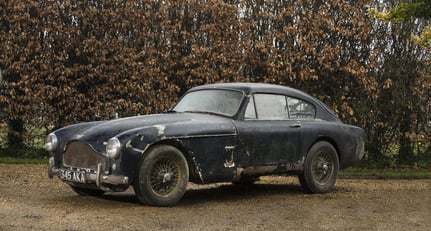1958 Aston Martin DB2
-
Baujahr1958
-
ChassisnummerAM300/3/1547
-
MotornummerDBA/1201
-
Losnummer201
-
LenkungLenkung links
-
ZustandGebraucht
-
Zahl der Sitze2
-
Standort

-
AußenfarbeSonstige
-
Antrieb2wd
-
KraftstoffPetrol
Beschreibung
1958 Aston Martin DB Mark III Sports Saloon
Coachwork by Tickford
Registration no. 345 AKA
Chassis no. AM300/3/1547
Engine no. DBA/1201
Two years after the introduction of the DB2/4 MkII came the DB MkIII - the '2/4' suffix being dropped - 551 of which, mainly saloons, were made between March 1957 and July 1959, 55% of which were exported. Externally the most obvious change was the adoption of a DB3S-style grille, establishing the 'hallmark' look of subsequent Aston Martins, which had been drawn up by Tickford designer, Bert Thickpenny. This restyled nose gave the car a more imposing look while the interior boasted a redesigned dashboard with instruments grouped in a cowled panel ahead of the driver.
The engine benefited from an extensive redesign by Tadek Marek (newly arrived from Austin) and featured, among other improvements, a stiffer block, stronger crankshaft and a new cylinder head with bigger valves. 162bhp was available with the single-pipe exhaust system, 178bhp with the optional twin-pipe version. Elsewhere there were improvements to both clutch and gearbox; Laycock overdrive became available and front disc brakes were standard rather than optional after the first 100 cars had been built, commencing at chassis '1401'. Despite the inevitable weight increase, the MkIII was faster than any of its predecessors with a top speed of 120mph. Unbeknown to many, the DB MkIII is another 'James Bond' Aston Martin, appearing in Ian Fleming's novel 'Goldfinger', though by the time the book made it to the screen the DB5 was the current model, so that was used instead.
The accompanying copy of the factory order form states that 'AM300/3/1547' was delivered new via agent C Williams to Littlewoods Pools Limited on 16th May 1958, while the old-style buff logbook shows that the Aston was first registered as '345 AKA' on 20th May that year to Littlewoods Mail Order Stores Limited. Overdrive, a twin exhaust system and an HMV radio are listed as non-standard equipment, though the latter two items have not survived. The car was returned to the factory for servicing at 1,296 miles (date unspecified) for the overdrive unit to be replaced.
In July 1961 the car passed to Mr Cecil Moores from the Littlewoods company of Freshwell, who appears to have kept it until March 1963. It stayed in the Liverpool area through two further owners before moving first to Rutland and then Wiltshire with the same owner from 1967 to 1972, when it moved to Portsmouth with the next owner. There is an MoT certificate on file issued by Stubbington Motors Limited, nr. Fareham, Hants, on 27th January 1973 at 39,871 miles, though it is not known whether or not this represents the first revolution of the odometer. Thereafter there appears to be no record of the car until the present owner purchased it privately on 24th June 1975.
The engine ran but the car was not roadworthy, in particular the front suspension turrets had split through the top rings and as replacements were not available at that time these were welded and polished. Nearly 40 years later they are still intact, although they should not be relied on today. Following many months of work (and trips to Aston Service Dorset) the car was successfully MoT'd on 21st May 1976 at 40,276 miles and re-registered, becoming the owner's daily transport. Fettling continued; in particular the brakes were rebuilt and a Mark II cylinder head fitted as the DBA unit had cracked between the valve seats and was beyond repair. The head was supplied by Aston Service Dorset and the machining work was carried out by Aero-Bonner at Shoreham Airport. The car was used daily in Holland and for trips into Germany and France. However, a mechanical failure resulted in damage to the offside body and rear chassis. The latter was repaired, although it appears not perfectly aligned, and the car re-commissioned, eventually returning to the UK in October 1977, since when it has been stored unused. Sold strictly as viewed, it comes with the original DBA inlet manifolds and a V5C registration document.























